Global trade is booming, and U.S. businesses need payment platforms that simplify international transactions, cut costs, and improve efficiency. This article reviews seven platforms tailored for cross-border payments, highlighting features, fees, and benefits for businesses expanding globally.
Key Platforms:
- PayPal Business: Popular for ease of use and global reach but with high fees (up to 8.5% per transaction).
- Wise: Transparent fees starting at 0.33% and mid-market exchange rates.
- Stripe: Developer-friendly with global payment tools and competitive fees (~6.21% for international payments).
- Payoneer: Ideal for freelancers and marketplaces, with free local transfers but some account fees.
- OFX: Great for large transfers with no fees for amounts over $10,000 and tight exchange rate margins.
- Revolut Business: Subscription-based plans with tiered allowances for transfers and currency exchanges.
- Airwallex: Supports 23 currencies, fast transfers, and flexible integration options.
Quick Comparison:
| Platform | Key Features | Fees | Ideal For |
|---|---|---|---|
| PayPal | Crypto payments, global reach, PayPal World | ~8.5% total fees | E-commerce and global transactions |
| Wise | Multi-currency accounts, low fees | 0.33%–1% per transfer | Cost-conscious businesses |
| Stripe | Developer tools, global coverage | ~6.21% for international | Tech-savvy companies |
| Payoneer | Marketplace integration, local accounts | 1%–3.99% | Freelancers, marketplaces |
| OFX | No fees for large transfers, FX tools | $15 (under $10k), 0.4%–1.5% | High-volume transfers |
| Revolut | Subscription plans, API integrations | $10–$90/month + 0.6% markup | SMEs and startups |
| Airwallex | Interbank FX rates, 90% same-day transfers | 0.5%–1% for FX, $15–$25 SWIFT | Global businesses |
Each platform offers unique strengths depending on your business size, transaction volume, and technical needs. Choose based on cost, integration options, and global coverage.
7 Best Payment Gateways of 2025
1. PayPal Business
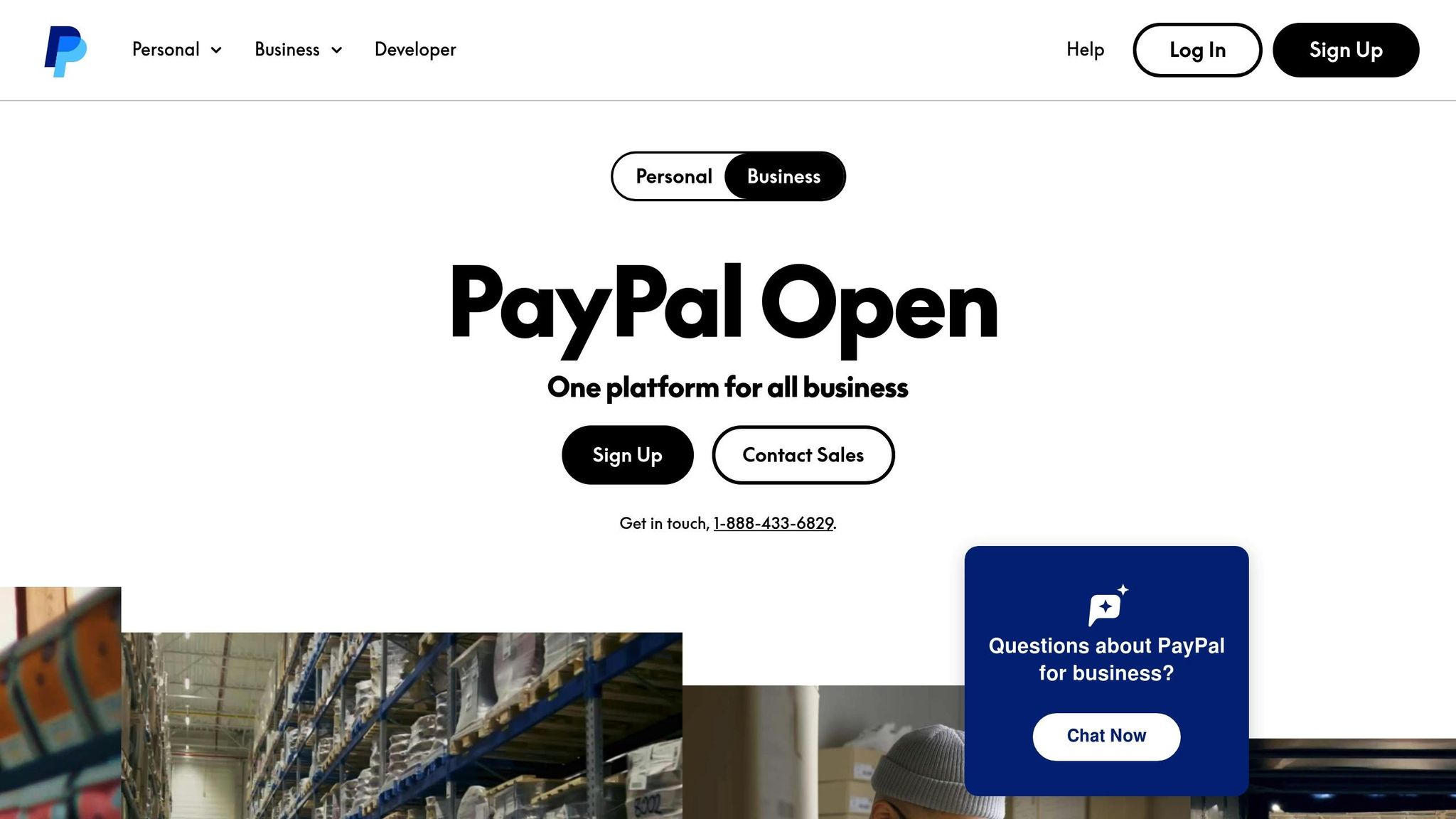
PayPal Business has grown into a robust digital payment platform, offering U.S. companies a range of tools for handling international transactions. Once primarily a peer-to-peer payment service, it now provides advanced features designed to simplify cross-border payments while aiming to cut costs and boost efficiency.
Key Features for International Payments
PayPal Business supports multiple methods for cross-border transactions, including the "Pay with Crypto" feature, which allows instant conversions between over 100 cryptocurrencies, stablecoins, and fiat currencies. This feature has the potential to slash transaction costs by up to 90% compared to traditional credit card processing for international payments. It also opens the door to the $3 trillion cryptocurrency market.
Another exciting development is PayPal World, set to launch in Fall 2025. This platform will unify global payment systems and digital wallets, making international commerce smoother. PayPal CEO Alex Chriss describes it as "a first-of-its-kind payments ecosystem that will bring together many of the world's largest payment systems and digital wallets on a single platform." With launch partners representing nearly two billion users worldwide, the initiative promises to significantly streamline cross-border transactions.
Fees and Costs
Understanding PayPal Business fees is essential for managing costs effectively. Here's a breakdown of the expenses for U.S. business accounts:
- Domestic transactions carry a 2.99% base fee plus a $0.49 fixed fee for payments in USD.
- International payments add a 1.50% cross-border surcharge, bringing the total to 4.49% plus the fixed fee for overseas transactions.
Currency conversion introduces additional costs. PayPal applies a rate that includes a 3%–4% markup above the mid-market rate. When all fees are combined, U.S. businesses may lose 7–8% of the transaction value. For instance, receiving a $2,000 payment from a UK client would incur approximately $170.29 in total fees, including transaction charges, cross-border surcharges, fixed fees, and currency conversion costs.
| Fee Component | Rate | Example on $2,000 |
|---|---|---|
| Base transaction fee | 2.99% | $59.80 |
| Cross-border surcharge | 1.50% | $30.00 |
| Fixed fee | $0.49 | $0.49 |
| Currency conversion | 4.00% | $80.00 |
| Total estimated fees | ~8.5% | $170.29 |
The "Pay with Crypto" feature offers a more affordable option, with a reduced 0.99% transaction fee available until July 31, 2026. This presents a significant cost-saving opportunity for businesses open to accepting cryptocurrency payments.
Integration Options for Businesses
PayPal Business offers three main integration methods:
- PayPal Buttons: A straightforward option for quick implementation.
- PayPal Payments Standard: Ideal for e-commerce platforms.
- API Integration: Customizable for businesses with complex technical needs.
The platform also supports multiple checkout methods through its JavaScript SDK, including PayPal Checkout, Expanded Checkout, and Enterprise Checkout. These options range from simple setups to highly customizable solutions, allowing businesses to choose the level of control that suits their requirements. PayPal's Sandbox environment further helps businesses test their integrations before going live.
Flexible Payout Services
PayPal Business offers versatile payout options, including bank transfers, virtual cards, and mobile wallets, making it easier to manage disbursements to international partners. CEO Alex Chriss highlights the platform's commitment to simplifying global expansion for businesses, stating, "Businesses of all sizes face incredible pressure when growing globally, from increased costs for accepting international payments to complex integrations. Today, we're removing these barriers and helping every business of every size achieve their goals".
PayPal Business is a reliable choice for U.S. companies looking for a well-established platform with extensive international reach. However, businesses should carefully consider the cumulative fees involved in cross-border transactions to ensure it aligns with their financial goals.
Next, we’ll take a closer look at Wise (formerly TransferWise) and its alternative solutions for cross-border payments.
2. Wise (formerly TransferWise)

Wise serves over 600,000 businesses and processes an impressive $145 billion in foreign exchange transactions annually [27, 30]. Its emphasis on transparency and speed has made it a go-to solution for U.S. companies managing cross-border payments. A key part of its appeal lies in its multi-currency capabilities.
Multi-Currency Business Account Features
Wise Business offers a multi-currency account that lets companies hold and exchange more than 40 currencies. It also provides local account details in up to nine major currencies, including USD, GBP, EUR, AUD, and SGD. This feature allows businesses to receive payments as if they had local bank accounts in those regions [28, 32]. For U.S.-based businesses, Wise enables payments to over 70 countries with low, clearly stated fees [27, 28].
Competitive Exchange Rates and Fee Structure
Wise uses the mid-market exchange rate without any hidden markups. As the company explains:
"We only use the mid-market exchange rate, so you don't sacrifice your money to mark-ups."
The pricing structure for U.S. businesses is straightforward. There’s a one-time $45 account setup fee, no monthly maintenance fees, and transaction fees starting at 0.33% for sending money. Receiving local payments is free, while USD SWIFT payments come with a fixed $6.11 fee.
| Fee Category | Cost |
|---|---|
| Account setup | $45 |
| Monthly maintenance | Free |
| Sending payments | From 0.33% |
| Receiving local payments | Free |
| USD SWIFT receipts | $6.11 |
Processing Speed and Reliability
Wise is known for its speed. About 65% of its payments are completed in under 20 seconds, and 95% are finalized within 24 hours. In the first quarter of 2024, 60% of transfers were completed instantly, while over 80% were done within an hour. Wise also boasts a Straight Through Processing rate of over 99%, minimizing manual interventions and ensuring smooth transactions [27, 35].
Business Integration and Automation Tools
Wise Business is designed to fit seamlessly into a company’s workflow. It integrates with popular accounting software like Xero and QuickBooks, making financial management easier. The platform also supports batch payments and offers API access for custom automation solutions. Additionally, customizable user access controls allow businesses to set permissions for team members handling international transactions [27, 28].
Security and Compliance Framework
Security is a top priority for Wise. The platform is regulated by leading financial authorities, including the FCA and FinCEN [27, 39, 41]. It employs 1,000 anti-fraud specialists who conduct 7 million security checks daily. Features like two-factor authentication, biometric verification, and bank-level encryption ensure the safety of transactions [39, 40]. As Wise states:
"Our promise is to protect every cent, dollar and peso with cutting-edge tech and anytime customer support."
To enhance security further, customer funds are kept separate from operational funds, and the platform uses machine learning and AI to detect suspicious activity [39, 40].
Customer Satisfaction and Limitations
Wise has a Trustpilot rating of 4.3/5 from over 255,000 reviews. Customers often highlight its competitive exchange rates, fast transfers, and transparent fee structure. However, some users have reported challenges with customer support and occasional difficulties during the business account application process. Additionally, while Wise excels at international payment processing, it doesn’t offer a full range of banking services, such as loans or investment products, which might require businesses to rely on traditional banks for those needs.
With its ability to handle significant transaction volumes and its focus on efficiency, Wise is a strong choice for U.S. businesses prioritizing cost-effective and fast international payments [35, 38].
3. Stripe
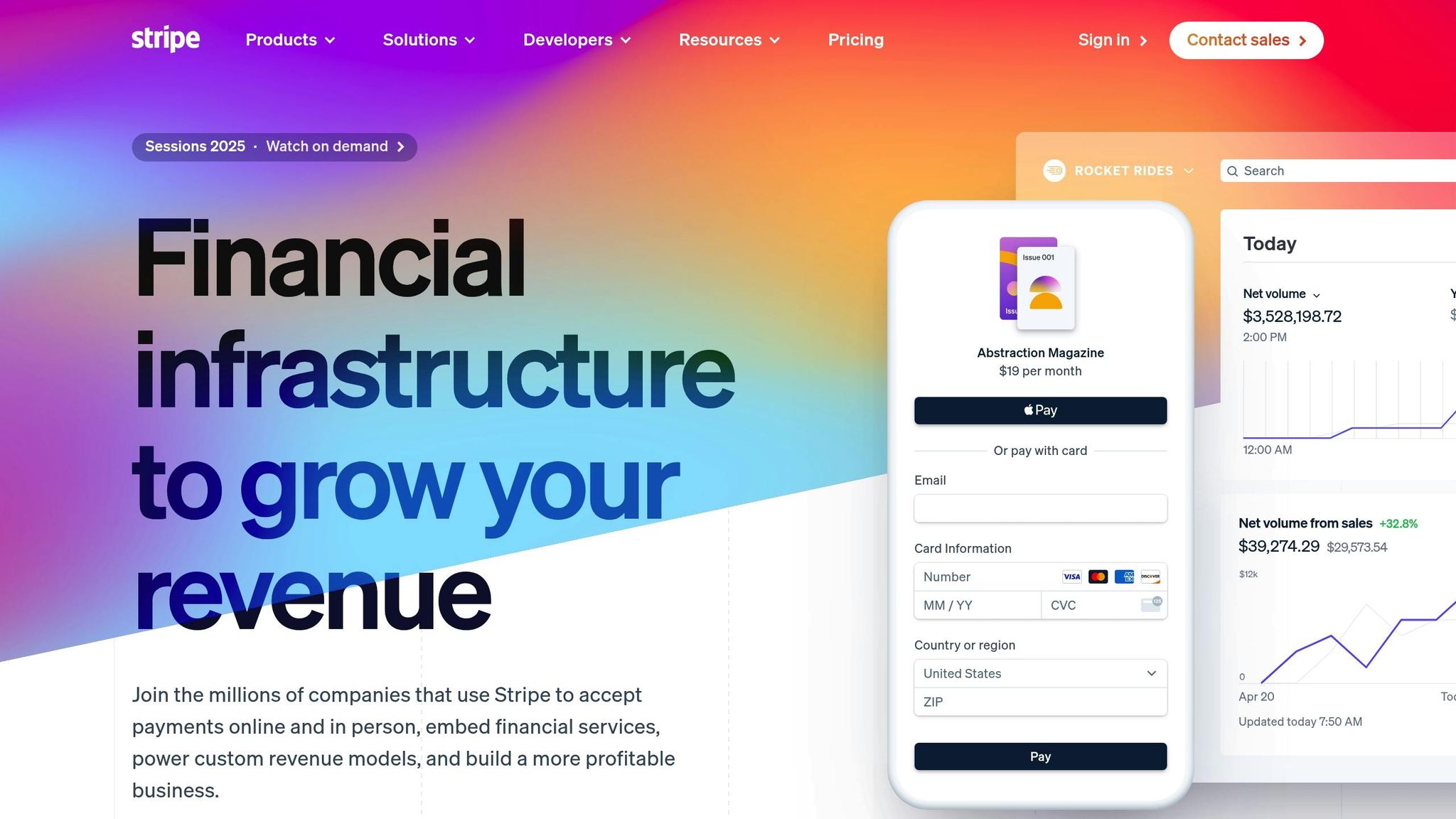
Stripe handled a staggering $2.8 trillion in cross-border payments in 2022. It serves businesses of all sizes, from small startups to massive global enterprises, and supports payments in over 195 countries and 135 currencies.
Global Payment Processing Capabilities
Stripe operates in 197 countries and offers local acquiring in 46 markets, while maintaining an impressive 99.999% uptime. This robust infrastructure allows U.S. businesses to accept payments worldwide without needing separate systems for each country.
Transaction Costs and Fee Structure
Stripe's pricing starts at 2.9% + $0.30 per transaction for domestic payments. For international payments, there’s an additional 1.5% surcharge, a 1–2% currency conversion fee, and a $15 dispute fee. Businesses with high transaction volumes may qualify for discounts, country-specific rates, or interchange plus pricing. For example, a $10,000 international transaction would incur approximately $621 in fees. These competitive rates align with Stripe’s focus on offering developer-friendly tools.
Developer Integration and API Tools
Stripe isn't just about payment processing - it’s a developer’s dream. The platform provides powerful APIs, SDKs, and integration tools across various programming languages. This developer-first approach has earned praise from companies like Shopify, which stated:
"Shopify has been doing this with Stripe for almost a decade, and we trust Stripe's DNA to always do the right thing for its customers. If you're good at building software, you think of APIs, architecture, speed, and resilience. This is what Stripe is so good at: making the complexity of money go away, being resilient, uptime, and beautiful APIs."
To make things even easier, Stripe offers specialized tools like Workbench, Developers Dashboard, and Stripe for Visual Studio Code to simplify debugging and integration. The Stripe Connect feature also provides prebuilt UIs, enabling companies to quickly embed payment workflows without heavy custom development.
Real-World Performance Results
Stripe’s platform has delivered measurable results for major companies. For example:
- Slack: Achieved a 3.5% boost in conversion rates and reduced fraud by 53% with Stripe's Payments Intelligence Suite.
- Twilio SendGrid: Increased conversions by 2% while cutting fraud by 90%.
- GitHub Sponsors Program: Saw a 52% rise in total contributions.
- DocuSign: Used Stripe to launch DocuSign Payments, allowing customers to collect signatures and payments simultaneously, creating a new revenue stream.
Security and Fraud Prevention
Stripe’s advanced fraud detection system, Stripe Radar, uses machine learning to identify and block fraudulent transactions. These tools have significantly reduced fraud for businesses like Twilio SendGrid, which reported a 90% drop in fraudulent activities.
Market Expansion Support
For businesses looking to expand internationally, Stripe simplifies global commerce. It handles currency conversions and ensures compliance with local regulations, making cross-border transactions seamless. With cross-border transactions expected to make up 33% of global ecommerce spending by 2028, Stripe positions U.S. businesses to thrive in an increasingly interconnected market. However, companies should carefully assess the associated fees for cross-border transactions to ensure cost-effectiveness.
4. Payoneer
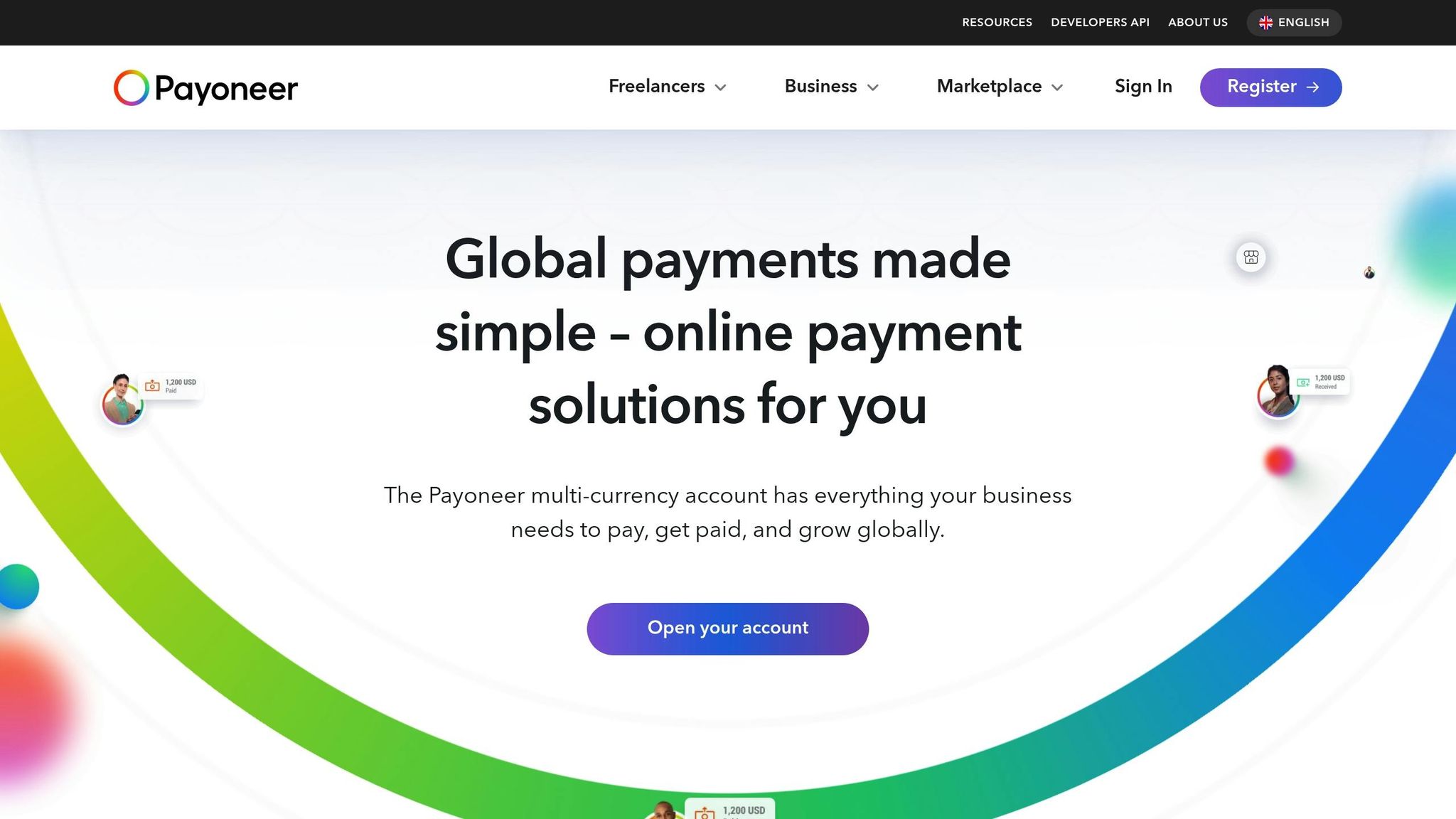
Payoneer supports over five million users across 190+ countries, handling transactions in more than 150 currencies. It also integrates with over 2,000 marketplaces, networks, and platforms, making it a popular choice for businesses with global operations.
Multi-Currency Account System
Payoneer’s multi-currency account setup allows businesses to receive payments in local currencies without dealing with conversion fees. Companies can hold receiving accounts in major currencies like EUR and GBP, enabling smooth local transactions.
Seamless Marketplace Integration
Payoneer connects effortlessly with prominent freelance, e-commerce, and affiliate platforms. This integration allows businesses to accept payments from a variety of international sources without requiring additional configurations.
Fees and Pricing Details
Payoneer’s fees vary based on transaction type and volume:
- Transfers between Payoneer accounts and local currency payments are free.
- Other transactions, such as USD payments, credit card transfers, ACH, and external withdrawals, come with fees ranging from 1% to 3.99%.
- High-volume users may qualify for flat fees or percentage-based rates on large transactions.
The platform also charges an annual inactivity fee of $29.95 for accounts with no transactions for 12 months. Currency conversion fees are generally 0.5% to 2% above the base exchange rate. For those using the Payoneer card, there’s an annual fee of $29.95, and currency conversion charges can reach up to 3.5%.
Security and Compliance Measures
Payoneer adheres to strict local regulations and employs advanced security protocols to ensure safe and trustworthy transactions.
User Feedback and Ratings
On mobile platforms, Payoneer users rate the service highly, averaging between 4.8 and 4.9 stars. However, Trustpilot reviews average around 3.8/5, with common complaints about withdrawal limits and occasional account restrictions.
Payoneer’s focus on simplifying global payments makes it a strong contender for businesses needing marketplace integration. Still, companies should carefully assess its fee structure to determine if it aligns with their transaction volumes and international payment needs. Up next, we’ll compare these features with other major platforms.
sbb-itb-165eed9
5. OFX
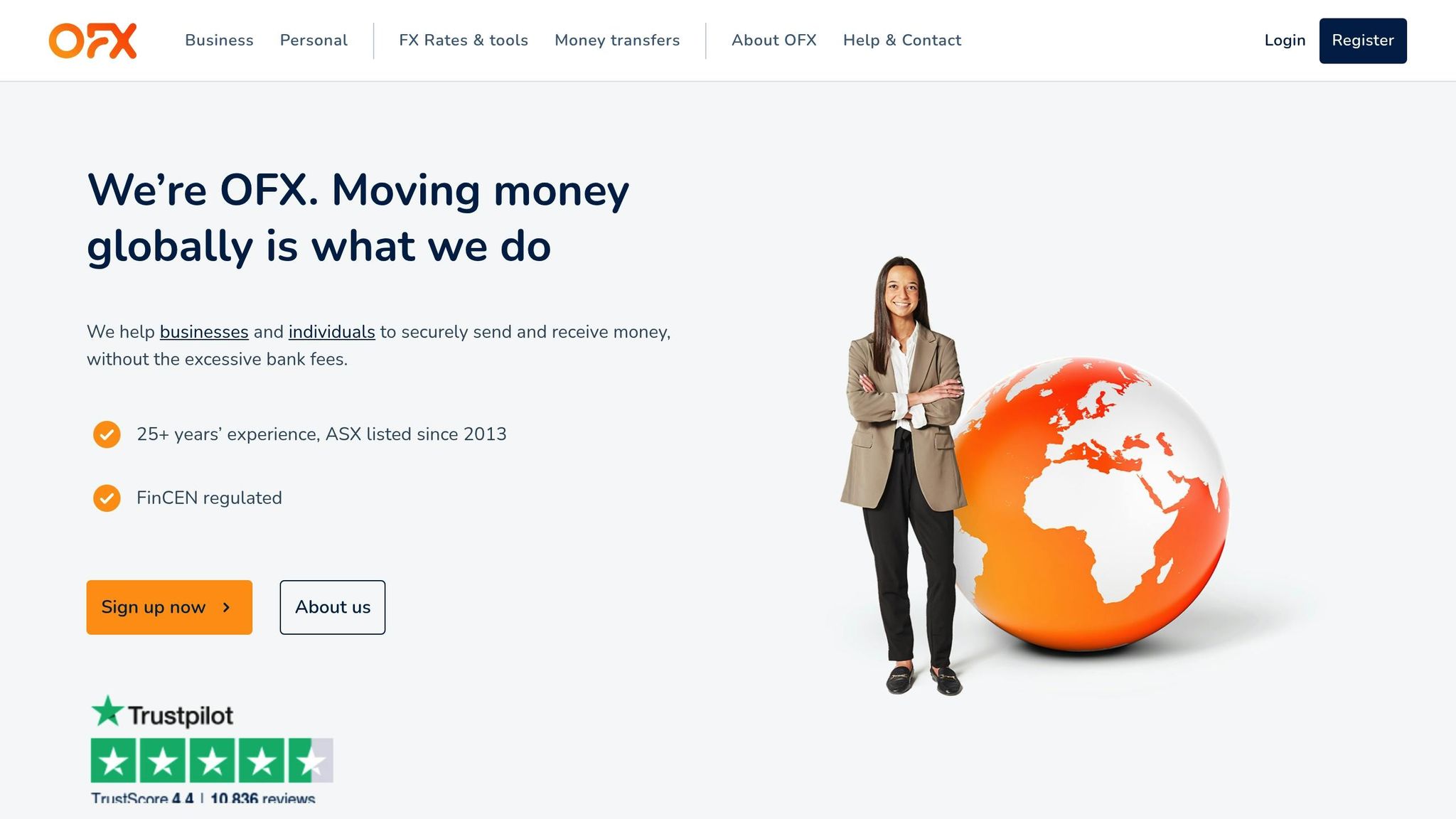
OFX handles over $20 billion in international transfers every year, serving a global customer base of more than 1 million people. The platform focuses on international payments and currency risk management, offering specialized tools and services to meet these needs.
Transparent Pricing and Competitive Rates
When it comes to pricing, OFX provides a clear and cost-effective structure, often delivering significant savings compared to traditional banks. With exchange rate margins typically 0.5–2% tighter than major banks, customers report saving anywhere from 15–25% on foreign exchange services. Here's how the fee structure breaks down:
- Transfers under $10,000: Flat $15 fee
- Transfers of $10,000 or more: No transfer fee
- Exchange rate margins: Typically range from 0.4% to 1.5% above the interbank rate
For popular currency pairs like AUD/USD, margins vary based on the transfer amount:
- Transfers under $10,000: 1.2–1.5% margin
- Transfers between $10,000 and $50,000: 0.8–1.2% margin
- Transfers over $50,000: 0.4–0.8% margin
Broad Currency Support and Quick Settlements
OFX supports transfers in over 50 currencies to more than 170 countries. For most major routes, funds are delivered within 1–3 business days. However, certain currencies may require up to 5 business days for processing [70,73]. The platform also offers a handy currency converter tool, which provides real-time rates and estimates any intermediary or bank fees upfront. These quick settlement times, paired with robust risk management tools, make OFX a reliable choice for global transactions.
Tools for Managing Currency Risk
OFX goes beyond offering competitive rates by helping businesses mitigate currency fluctuations. One standout feature is their forward contracts, which allow customers to lock in exchange rates for up to 12 months. Additionally, dedicated account managers provide in-depth market insights and strategic advice to navigate volatile currency markets.
Technology and Integration
The OFX platform is equipped with real-time rate displays, contract management tools, and API integration, ensuring smooth connectivity with existing workflows.
A Real-Life Success Story
Take FIREX Distribution, an Australian import business, as an example. By switching from bank forward contracts to OFX, they saved over $12,000 annually. The reduced margins and enhanced service allowed them to offer better prices to their retail customers while safeguarding their profit margins.
Security and Compliance
OFX operates under strict regulatory oversight in multiple jurisdictions, including supervision by ASIC in Australia, ensuring secure and compliant international transactions.
Customer Feedback and Support
With a 4.4/5 rating on Trustpilot, OFX has earned praise from 89% of reviewers who rated their experience as Excellent or Good. While some users initially find forward contracts or margin requirements during volatile periods a bit complex, OFX addresses these concerns through educational resources like webinars and market updates.
6. Revolut Business
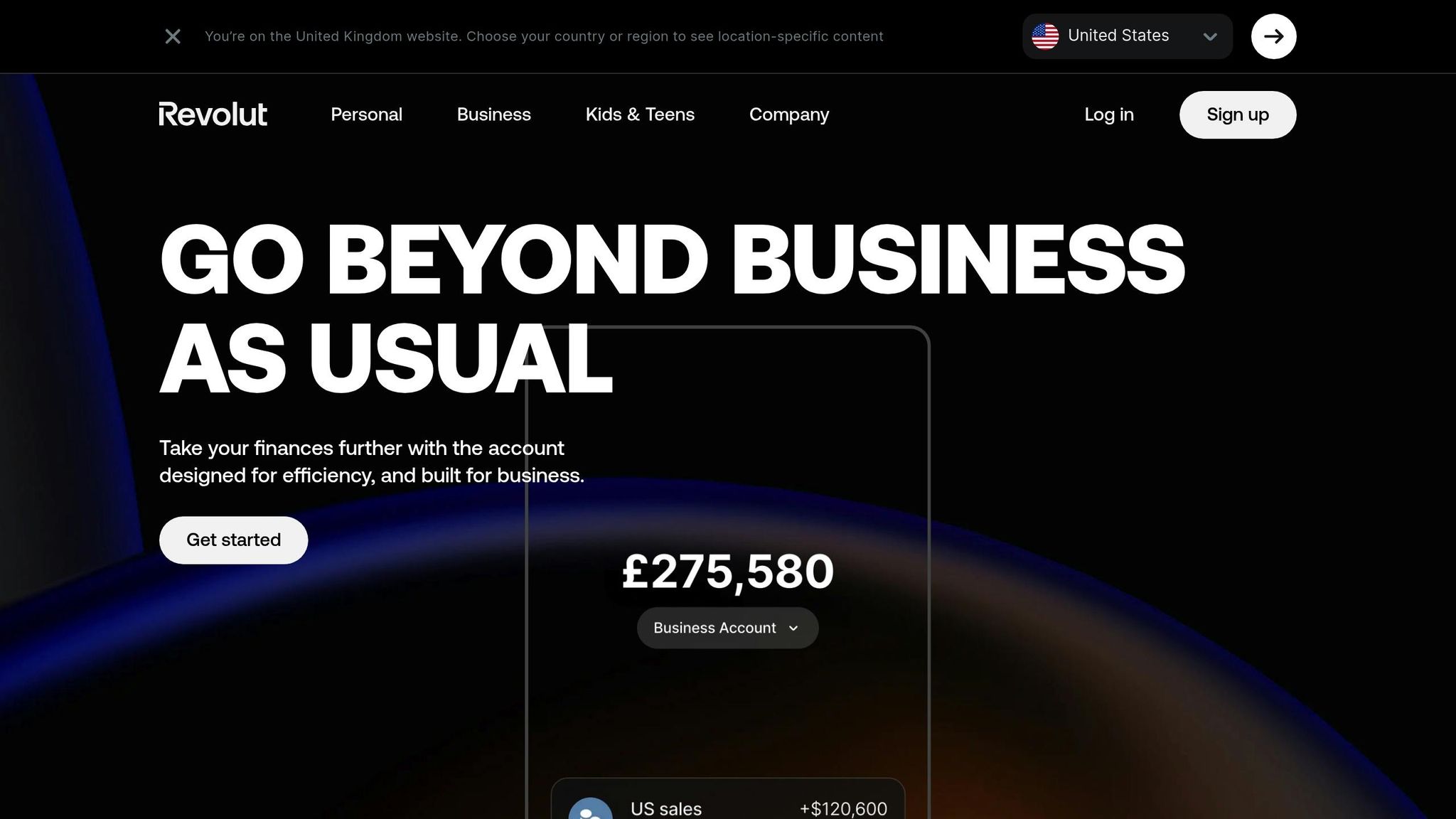
Revolut Business is a digital banking platform tailored for freelancers, startups, and small to medium-sized enterprises (SMEs), spanning more than 40 countries. It supports international transfers in over 25 currencies to 150+ destinations and allows businesses to hold balances in up to 34 currencies. Let’s dive into its pricing structure and standout features.
Tiered Pricing Structure with Monthly Allowances
Revolut Business uses a subscription-based model with four pricing tiers, each offering different benefits for international transfers and currency exchange:
| Plan | Monthly Fee | International Transfers | Currency Exchange Allowance | Fee Beyond Limit |
|---|---|---|---|---|
| Basic | $10 | $5.00 per transfer | $1,000 at interbank rate | 0.6% markup |
| Grow | $30 | 5 free, then $5.00 each | $10,000 at interbank rate | 0.6% markup |
| Scale | $90 | 25 free, then $5.00 each | $50,000 at interbank rate | 0.6% markup |
| Enterprise | Custom | Custom terms | Custom terms | Custom terms |
Currency exchanges made outside foreign exchange market hours incur an additional 1.0% fee. These clear pricing tiers make it easier for businesses to manage multi-currency transactions effectively.
Multi-Currency Support and Processing Times
Revolut Business enables transactions in over 25 currencies across more than 150 destinations. Transfers between Revolut accounts are instant and free, while standard international transfers via SWIFT typically take 1–3 business days. The platform also boasts a Payment Gateway with a 98.5% success rate and a payment abandonment rate of under 10% for Revolut Pay.
API Integration and Automation Capabilities
Revolut Business goes beyond basic banking with its powerful API, designed to streamline financial operations. The API allows businesses to automate tasks like viewing accounts, managing counterparties, processing payments, and exchanging currencies - all without manual effort. It supports four security scopes, with tokens expiring after 40 minutes for added security. Businesses can also use the API to automate payouts for sellers, freelancers, and service providers, as well as issue virtual cards at scale.
Real-World Business Applications
Many companies have incorporated Revolut Business into their operations. Alberto Espinos, CEO & Co-founder of Tropicfeel, shared:
"Fast payments, transparency on exact amounts, and no hidden fees really help build supplier trust."
Similarly, Daniel Westgarth, COO of Deel, highlighted:
"Revolut Business helps us process payments around the world with ease - giving us the reach, control, and visibility we need."
Compliance and Security Considerations
Global payment platforms like Revolut Business face strict compliance requirements. In April 2025, Lithuania's central bank fined Revolut Bank €3.5 million for shortcomings in its anti-money laundering (AML) processes. The regulator pointed out lapses in monitoring suspicious transactions, though it confirmed no money laundering occurred (Flagright, 2025).
Customer Satisfaction Trends
Customer satisfaction has seen a decline, with ratings dropping to an average of 1.9/5 since early 2024. While the platform offers robust features, this trend signals a need for improvements to meet user expectations.
Integration Ecosystem
Revolut Business stands out with its integration options, connecting seamlessly with tools like Xero, Slack, QuickBooks, and Zapier. It also supports various payment methods, including Payment Links, Payment Gateway, Payment QR Codes, Revolut Reader, and Revolut Pay, catering to diverse business needs.
7. Airwallex
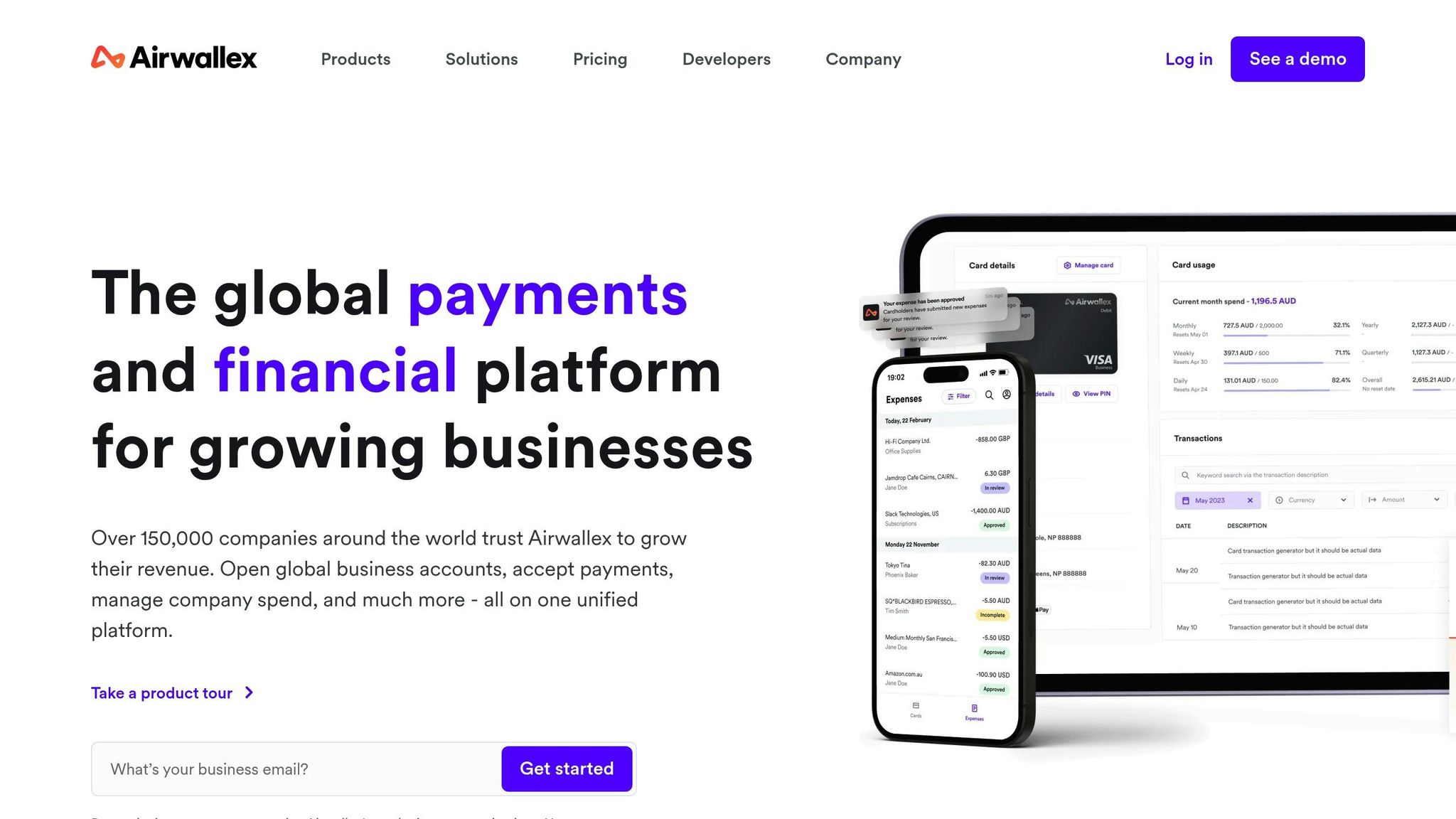
Airwallex offers a robust solution for global payments, catering to over 150,000 cross-border businesses and processing more than $150 billion in payments annually.
Pricing Structure
Airwallex uses a three-tier pricing model: Explore (free), Grow ($99/month), and Accelerate (custom pricing). Monthly fees can be waived if businesses meet minimum balance or deposit requirements. Transaction fees depend on the payment method and location:
- Domestic card payments: 2.8% + $0.30
- International card payments: 4.30% + $0.30
- Local payments: $0.30 plus a payment method fee
- SWIFT transfers: $15–$25
Currency Exchange and Payment Features
Airwallex supports holding and exchanging 23 currencies and facilitates payments to over 120 countries. It offers interbank FX rates with a 0.5% markup for major currencies and 1% for others. Businesses can use pre-funding (wallet balances) or post-funding workflows (booking conversions up to set limits). Impressively, 90% of international transfers are completed on the same day.
The platform also supports 160+ local payment methods across 180+ countries and provides same-currency settlement in 14+ currencies. To reduce foreign exchange costs, Airwallex offers two key features:
- Automatic Currency Conversion: Dynamically converts pricing into customers' local currencies across 180+ countries, with a 2–4% conversion fee.
- Multi-currency Pricing: Allows businesses to display stable local prices and locks FX rates for up to 72 hours, eliminating currency risk.
Integration and API Options
Airwallex provides flexible integration solutions tailored to different business needs. Options include no-code eCommerce plugins, hosted payment pages, drop-in elements, and APIs with mobile SDKs. This range of tools ensures businesses can align their payment systems with their technical resources and customer experience goals.
| Integration Type | Key Benefits | Considerations |
|---|---|---|
| API Integration | Full control over the payment experience | Requires developer resources and maintenance |
| Hosted Payment Pages | Simplifies PCI compliance; quick to implement | Limited design customization |
| Plugins and Extensions | Easy setup; ideal for small businesses | Limited flexibility; reliant on third-party updates |
| Payment Links | No technical setup; shareable across platforms | Limited branding; less scalability |
Security and Regulatory Standards
Airwallex prioritizes security and compliance, holding 60+ global banking licenses and adhering to standards like SSL, TLS, SOC1, SOC2, and PCI DSS. The company is also working toward ISO 27001 and CSA STAR certifications. Each user undergoes a Know Your Customer (KYC) process, and the platform employs anti–money laundering measures. Its 3DS risk engine and compliance with PCI DSS ensure secure transactions. In January 2025, Airwallex US highlighted the platform's global compliance, stating:
"By integrating with secure and globally compliant financial infrastructure, your marketplace can confidently enter new markets, build trust, and maintain a strong reputation."
Key Considerations for Businesses
When considering Airwallex, businesses should evaluate their international transaction volume, payment preferences, and ability to maintain minimum balances to ensure the fee structure aligns with their needs. The platform is especially beneficial for companies that strategically manage balances, batch smaller payments, or time larger transactions to minimize costs. Integration with accounting tools also simplifies tax reporting, making Airwallex a practical choice for businesses handling complex financial operations across multiple jurisdictions. By streamlining local-currency processing and centralizing financial management, Airwallex addresses many challenges of global trade.
Platform Comparison: Advantages and Disadvantages
Choosing the right payment platform for global trade means evaluating how each option stacks up in key areas like cost, speed, and usability. This comparison highlights the strengths and limitations of seven platforms, each offering distinct features that can impact your international operations.
Transaction fees are one of the most noticeable differences. Wise stands out with its competitive rates starting at 0.33% for money transfers, using mid-market rates without hidden markups. OFX, on the other hand, charges a flat $15 fee for transfers under $10,000 but waives fees entirely for larger transactions, making it a strong choice for high-volume transfers. Revolut’s tiered pricing benefits businesses with moderate monthly transaction volumes.
Currency coverage is another key factor. Some platforms, like Airwallex, support up to 23 currencies and facilitate payments to over 120 countries. They also offer same-currency settlements in 14+ currencies, which avoids unnecessary conversion fees when both parties use the same currency. Digital wallets are a faster alternative, enabling instant payments, though they may impose daily limits.
Hidden fees can significantly impact costs. David Britten, Managing Director for Corpay in APAC, notes that hidden fees in cross-border transactions average 3.39%:
"The recent Currency conversion and the hidden costs of global trade whitepaper study...reveals that the average premium charge to send payments across borders is at a rate of 3.39 per cent."
Integration capabilities also vary widely. Stripe is a favorite among developers, offering robust APIs and extensive documentation for custom solutions. PayPal Business, however, provides simple plug-and-play options, perfect for smaller businesses with limited technical resources. Airwallex offers flexible integration options, catering to a range of technical needs.
Compliance and security standards are essential for managing risk in global trade. Most platforms use strong encryption and adhere to standards like SSL, TLS, SOC, and PCI DSS, along with KYC and anti–money laundering measures. However, the extent of global regulatory coverage differs across platforms, which could impact their suitability for businesses operating in highly regulated markets.
The best platform often depends on your business size and transaction patterns. For example, OFX is ideal for businesses making frequent large transfers due to its fee structure, while Revolut Business works well for companies with moderate transaction volumes that benefit from tiered pricing. Wise is a go-to choice for businesses focused on transparent pricing and mid-market rates, regardless of transaction size.
Market acceptance is another consideration. PayPal is widely recognized by consumers worldwide, making it a strong option for B2C transactions. Stripe excels in online commerce integration, while Payoneer is a popular choice for marketplace and freelance payments.
Final Recommendations
Choosing the right cross-border payment platform for your U.S. business means taking a closer look at your specific needs and operational goals. Start by analyzing key factors like your monthly transaction volumes, average payment amounts, and the markets you’re targeting. For context, the Federal Reserve reported that in 2022, average credit card fees were 1.40% per transaction, while debit card fees were $0.34 or 0.74% per transaction. Use these benchmarks to gauge if a platform’s pricing is in line with industry norms.
Security should be a top priority. Make sure the platform complies with current PCI DSS standards, offers encryption and tokenization, and includes robust fraud prevention tools. As payment fraud becomes more sophisticated, these features are essential to protect both your business and your customers.
Scalability is another critical factor. Your platform should handle growing transaction volumes without sacrificing performance or driving up costs. It’s also important to choose a provider that supports a variety of payment methods, from credit and debit cards to digital wallets. With an estimated 5.3 billion global ecommerce users projected by 2027, offering payment flexibility will be key to meeting customer expectations.
Integration capabilities are equally important. Look for a platform that connects seamlessly with your existing systems to simplify operations. Some providers offer plug-and-play setups, while others provide APIs for custom integrations. The right choice will depend on your technical resources and specific needs.
Round-the-clock support is non-negotiable. International transactions can face challenges at any time, so 24/7 customer service, implementation assistance, and dedicated account management are essential for uninterrupted operations.
Don’t overlook geographic coverage and currency support. Assess whether the platform supports the countries, currencies, and payment methods that align with your current operations and future growth plans. These elements are crucial for ensuring your payment strategy can keep up with your expansion goals.
Finally, take advantage of resources like the Cross Border Payments Companies directory. This tool offers detailed provider profiles and feature comparisons, including API availability, pricing, and coverage areas. It’s an invaluable resource for making an informed decision based on your unique criteria rather than just brand recognition or upfront costs.
FAQs
What should businesses look for in a payment platform for international transactions?
When choosing a payment platform for international transactions, there are several critical aspects to weigh. Start with geographic coverage and currency support - you’ll want a platform that can handle payments in all the countries and currencies where your business operates. Keeping an eye on transaction fees and currency conversion costs is equally important, as these can significantly impact your bottom line.
Security should never be overlooked. Opt for platforms that offer strong protections, such as PCI DSS compliance, to safeguard sensitive customer and business data. Also, think about the platform’s ability to grow with your business. Look for integration capabilities to ensure it works seamlessly with your existing systems. Lastly, offering a variety of payment methods can make transactions smoother for your customers, enhancing their overall experience.
How do payment platforms manage currency conversion, and how does it affect transaction costs?
Payment platforms manage currency conversion through methods like real-time exchange rates, locked-in FX rates, and multi-currency accounts. With real-time conversion, the platform uses the current market rate at the moment of the transaction. While this approach reflects the most up-to-date rates, it can lead to unpredictable costs due to market swings. On the other hand, locked-in rates offer stability by setting a fixed exchange rate, though this often comes with extra fees. Multi-currency accounts allow businesses to hold and operate in multiple currencies, minimizing the need for constant conversions.
Each method impacts transaction costs differently. Real-time conversion can lead to higher fees when markets are volatile. Locked-in rates and multi-currency accounts, however, provide more control over expenses and can make financial planning easier. Selecting the right approach plays a critical role in managing the profitability of international transactions.
What security features do payment platforms use to protect international transactions?
Payment platforms incorporate a range of security measures to keep international transactions secure and trustworthy. Among these are encryption technologies like SSL/TLS, which protect data during transmission, and multi-factor authentication (MFA), ensuring that only authorized users can access accounts. Additionally, many platforms adhere to strict industry standards, such as PCI DSS, to protect payment card details.
To strengthen protection even further, many platforms use tokenization, replacing sensitive information with unique tokens that are useless to hackers. They also conduct regular security audits to uncover and fix potential vulnerabilities. Together, these strategies help prevent fraud and unauthorized access, giving businesses confidence when handling cross-border payments.


